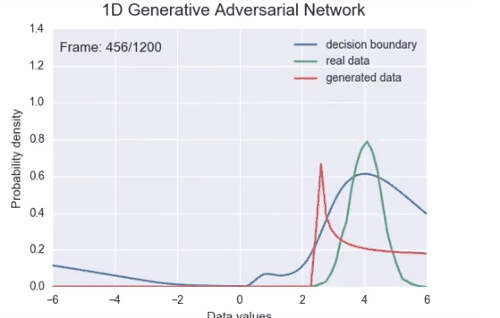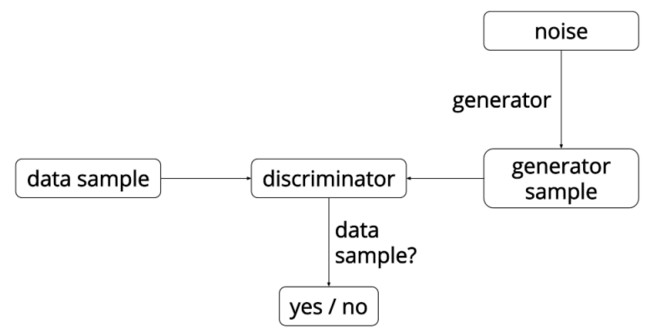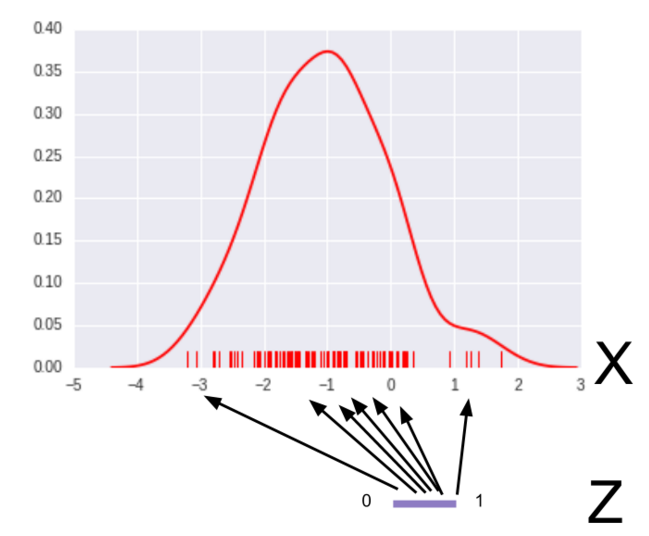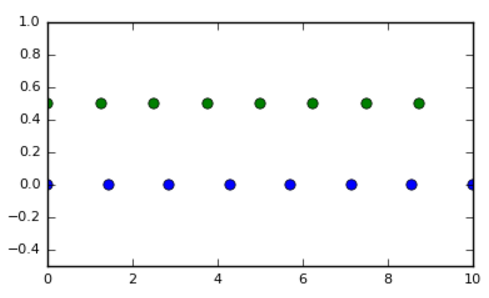今天我们接着上一讲“#9 生成对抗网络101 终极入门与通俗解析”, 手把手教你写一个生成对抗网络。参考代码是:https://github.com/AYLIEN/gan-intro
关键python库: TensorFlow, numpy, matplotlib, scipy
我们上次讲过,生成对抗网络同时训练两个模型, 叫做生成器和判断器. 生成器竭尽全力模仿真实分布生成数据; 判断器竭尽全力区分出真实样本和生成器生成的模仿样本. 直到判断器无法区分出真实样本和模仿样本为止.

上图是一个生成对抗网络的训练过程,我们所要讲解的代码就是要实现这样的训练过程。
其中, 绿色线的分布是一个高斯分布(真实分布),期望和方差都是固定值,所以分布稳定。红色线的分布是生成器分布,他在训练过程中与判断器对抗,不断改变分布模仿绿色线高斯分布. 整个过程不断模仿绿色线。蓝色线的分布就是判断器,约定为, 概率密度越高, 认为真实数据的可能性越大. 可以看到蓝线在真实数据期望4的地方,蓝色线概率密度越来越小, 即, 判断器难区分出生成器和判断器.
接下来我们来啃一下David 9看过最复杂的TensorFlow源码逻辑:
首先看总体逻辑:

正像之前所说, 有两个神经模型在交替训练. 生成模型输入噪声分布, 把噪声分布映射成很像真实分布的分布, 生成仿造的样本. 判断模型输入生成模型的仿造样本, 区分这个样本是不真实样本. 如果最后区分不出, 恭喜你, 模型训练的很不错.
我们的生成器模型映射作用很像下图:
Z是一个平均分布加了点噪声而已. X是真实分布. 我们希望这个神经网络输入相同间隔的输入值 , 输出就能告诉我们这个值的概率密度(pdf)多大? 很显然-1这里pdf应该比较大.
Z如何写代码? 很简单:
class GeneratorDistribution(object):
def __init__(self, range):
self.range = range
def sample(self, N):
return np.linspace(-self.range, self.range, N) + \
np.random.random(N) * 0.01
查不多采样值像下图:
只是多了一点点噪声而已.
生成器用一层线性, 加一层非线性, 最后加一层线性的神经网络.
判断器需要强大一些, 用三层线神经网络去做:
def discriminator(input, hidden_size):
h0 = tf.tanh(linear(input, hidden_size * 2, 'd0'))
h1 = tf.tanh(linear(h0, hidden_size * 2, 'd1'))
h2 = tf.tanh(linear(h1, hidden_size * 2, 'd2'))
h3 = tf.sigmoid(linear(h2, 1, 'd3'))
return h3
然后, 我们构造TensorFlow图, 还有判断器和生成器的损失函数:
with tf.variable_scope('G'):
z = tf.placeholder(tf.float32, shape=(None, 1))
G = generator(z, hidden_size)
with tf.variable_scope('D') as scope:
x = tf.placeholder(tf.float32, shape=(None, 1))
D1 = discriminator(x, hidden_size)
scope.reuse_variables()
D2 = discriminator(G, hidden_size)
loss_d = tf.reduce_mean(-tf.log(D1) - tf.log(1 - D2))
loss_g = tf.reduce_mean(-tf.log(D2))
最神奇的应该是这句:
loss_d = tf.reduce_mean(-tf.log(D1) - tf.log(1 - D2))
我们有同样的一个判断模型, D1和D2的区别仅仅是D1的输入是真实数据, D2的输入是生成器的伪造数据. 注意, 代码中判断模型的输出是“认为一个样本在真实分布中的可能性”. 所以优化时目标是, D1的输出要尽量大, D2的输出要尽量小.
此外, 优化生成器的时候, 我们要欺骗判断器, 让D2的输出尽量大:
loss_g = tf.reduce_mean(-tf.log(D2))
最难的难点, David 9 给大家已经讲解了. 如何写优化器(optimizer)和训练过程, 请大家参考源代码~
源代码:
'''
An example of distribution approximation using Generative Adversarial Networks in TensorFlow.
Based on the blog post by Eric Jang: http://blog.evjang.com/2016/06/generative-adversarial-nets-in.html,
and of course the original GAN paper by Ian Goodfellow et. al.: https://arxiv.org/abs/1406.2661.
The minibatch discrimination technique is taken from Tim Salimans et. al.: https://arxiv.org/abs/1606.03498.
'''
from __future__ import absolute_import
from __future__ import print_function
from __future__ import unicode_literals
from __future__ import division
import argparse
import numpy as np
from scipy.stats import norm
import tensorflow as tf
import matplotlib.pyplot as plt
from matplotlib import animation
import seaborn as sns
sns.set(color_codes=True)
seed = 42
np.random.seed(seed)
tf.set_random_seed(seed)
class DataDistribution(object):
def __init__(self):
self.mu = 4
self.sigma = 0.5
def sample(self, N):
samples = np.random.normal(self.mu, self.sigma, N)
samples.sort()
return samples
class GeneratorDistribution(object):
def __init__(self, range):
self.range = range
def sample(self, N):
return np.linspace(-self.range, self.range, N) + \
np.random.random(N) * 0.01
def linear(input, output_dim, scope=None, stddev=1.0):
norm = tf.random_normal_initializer(stddev=stddev)
const = tf.constant_initializer(0.0)
with tf.variable_scope(scope or 'linear'):
w = tf.get_variable('w', [input.get_shape()[1], output_dim], initializer=norm)
b = tf.get_variable('b', [output_dim], initializer=const)
return tf.matmul(input, w) + b
def generator(input, h_dim):
h0 = tf.nn.softplus(linear(input, h_dim, 'g0'))
h1 = linear(h0, 1, 'g1')
return h1
def discriminator(input, h_dim, minibatch_layer=True):
h0 = tf.tanh(linear(input, h_dim * 2, 'd0'))
h1 = tf.tanh(linear(h0, h_dim * 2, 'd1'))
# without the minibatch layer, the discriminator needs an additional layer
# to have enough capacity to separate the two distributions correctly
if minibatch_layer:
h2 = minibatch(h1)
else:
h2 = tf.tanh(linear(h1, h_dim * 2, scope='d2'))
h3 = tf.sigmoid(linear(h2, 1, scope='d3'))
return h3
def minibatch(input, num_kernels=5, kernel_dim=3):
x = linear(input, num_kernels * kernel_dim, scope='minibatch', stddev=0.02)
activation = tf.reshape(x, (-1, num_kernels, kernel_dim))
diffs = tf.expand_dims(activation, 3) - tf.expand_dims(tf.transpose(activation, [1, 2, 0]), 0)
eps = tf.expand_dims(np.eye(int(input.get_shape()[0]), dtype=np.float32), 1)
abs_diffs = tf.reduce_sum(tf.abs(diffs), 2) + eps
minibatch_features = tf.reduce_sum(tf.exp(-abs_diffs), 2)
return tf.concat(1, [input, minibatch_features])
def optimizer(loss, var_list):
initial_learning_rate = 0.005
decay = 0.95
num_decay_steps = 150
batch = tf.Variable(0)
learning_rate = tf.train.exponential_decay(
initial_learning_rate,
batch,
num_decay_steps,
decay,
staircase=True
)
optimizer = tf.train.GradientDescentOptimizer(learning_rate).minimize(
loss,
global_step=batch,
var_list=var_list
)
return optimizer
class GAN(object):
def __init__(self, data, gen, num_steps, batch_size, minibatch, log_every, anim_path):
self.data = data
self.gen = gen
self.num_steps = num_steps
self.batch_size = batch_size
self.minibatch = minibatch
self.log_every = log_every
self.mlp_hidden_size = 4
self.anim_path = anim_path
self.anim_frames = []
self._create_model()
def _create_model(self):
# In order to make sure that the discriminator is providing useful gradient
# information to the generator from the start, we're going to pretrain the
# discriminator using a maximum likelihood objective. We define the network
# for this pretraining step scoped as D_pre.
with tf.variable_scope('D_pre'):
self.pre_input = tf.placeholder(tf.float32, shape=(self.batch_size, 1))
self.pre_labels = tf.placeholder(tf.float32, shape=(self.batch_size, 1))
D_pre = discriminator(self.pre_input, self.mlp_hidden_size, self.minibatch)
self.pre_loss = tf.reduce_mean(tf.square(D_pre - self.pre_labels))
self.pre_opt = optimizer(self.pre_loss, None)
# This defines the generator network - it takes samples from a noise
# distribution as input, and passes them through an MLP.
with tf.variable_scope('G'):
self.z = tf.placeholder(tf.float32, shape=(self.batch_size, 1))
self.G = generator(self.z, self.mlp_hidden_size)
# The discriminator tries to tell the difference between samples from the
# true data distribution (self.x) and the generated samples (self.z).
#
# Here we create two copies of the discriminator network (that share parameters),
# as you cannot use the same network with different inputs in TensorFlow.
with tf.variable_scope('D') as scope:
self.x = tf.placeholder(tf.float32, shape=(self.batch_size, 1))
self.D1 = discriminator(self.x, self.mlp_hidden_size, self.minibatch)
scope.reuse_variables()
self.D2 = discriminator(self.G, self.mlp_hidden_size, self.minibatch)
# Define the loss for discriminator and generator networks (see the original
# paper for details), and create optimizers for both
#self.pre_loss = tf.reduce_mean(tf.square(D_pre - self.pre_labels))
self.loss_d = tf.reduce_mean(-tf.log(self.D1) - tf.log(1 - self.D2))
self.loss_g = tf.reduce_mean(-tf.log(self.D2))
vars = tf.trainable_variables()
self.d_pre_params = [v for v in vars if v.name.startswith('D_pre/')]
self.d_params = [v for v in vars if v.name.startswith('D/')]
self.g_params = [v for v in vars if v.name.startswith('G/')]
#self.pre_opt = optimizer(self.pre_loss, self.d_pre_params)
self.opt_d = optimizer(self.loss_d, self.d_params)
self.opt_g = optimizer(self.loss_g, self.g_params)
def train(self):
with tf.Session() as session:
tf.initialize_all_variables().run()
# pretraining discriminator
num_pretrain_steps = 1000
for step in xrange(num_pretrain_steps):
d = (np.random.random(self.batch_size) - 0.5) * 10.0
labels = norm.pdf(d, loc=self.data.mu, scale=self.data.sigma)
pretrain_loss, _ = session.run([self.pre_loss, self.pre_opt], {
self.pre_input: np.reshape(d, (self.batch_size, 1)),
self.pre_labels: np.reshape(labels, (self.batch_size, 1))
})
self.weightsD = session.run(self.d_pre_params)
# copy weights from pre-training over to new D network
for i, v in enumerate(self.d_params):
session.run(v.assign(self.weightsD[i]))
for step in xrange(self.num_steps):
# update discriminator
x = self.data.sample(self.batch_size)
z = self.gen.sample(self.batch_size)
loss_d, _ = session.run([self.loss_d, self.opt_d], {
self.x: np.reshape(x, (self.batch_size, 1)),
self.z: np.reshape(z, (self.batch_size, 1))
})
# update generator
z = self.gen.sample(self.batch_size)
loss_g, _ = session.run([self.loss_g, self.opt_g], {
self.z: np.reshape(z, (self.batch_size, 1))
})
if step % self.log_every == 0:
#pass
print('{}: {}\t{}'.format(step, loss_d, loss_g))
if self.anim_path:
self.anim_frames.append(self._samples(session))
if self.anim_path:
self._save_animation()
else:
self._plot_distributions(session)
def _samples(self, session, num_points=10000, num_bins=100):
'''
Return a tuple (db, pd, pg), where db is the current decision
boundary, pd is a histogram of samples from the data distribution,
and pg is a histogram of generated samples.
'''
xs = np.linspace(-self.gen.range, self.gen.range, num_points)
bins = np.linspace(-self.gen.range, self.gen.range, num_bins)
# decision boundary
db = np.zeros((num_points, 1))
for i in range(num_points // self.batch_size):
db[self.batch_size * i:self.batch_size * (i + 1)] = session.run(self.D1, {
self.x: np.reshape(
xs[self.batch_size * i:self.batch_size * (i + 1)],
(self.batch_size, 1)
)
})
# data distribution
d = self.data.sample(num_points)
pd, _ = np.histogram(d, bins=bins, density=True)
# generated samples
zs = np.linspace(-self.gen.range, self.gen.range, num_points)
g = np.zeros((num_points, 1))
for i in range(num_points // self.batch_size):
g[self.batch_size * i:self.batch_size * (i + 1)] = session.run(self.G, {
self.z: np.reshape(
zs[self.batch_size * i:self.batch_size * (i + 1)],
(self.batch_size, 1)
)
})
pg, _ = np.histogram(g, bins=bins, density=True)
return db, pd, pg
def _plot_distributions(self, session):
db, pd, pg = self._samples(session)
db_x = np.linspace(-self.gen.range, self.gen.range, len(db))
p_x = np.linspace(-self.gen.range, self.gen.range, len(pd))
f, ax = plt.subplots(1)
ax.plot(db_x, db, label='decision boundary')
ax.set_ylim(0, 1)
plt.plot(p_x, pd, label='real data')
plt.plot(p_x, pg, label='generated data')
plt.title('1D Generative Adversarial Network')
plt.xlabel('Data values')
plt.ylabel('Probability density')
plt.legend()
plt.show()
def _save_animation(self):
f, ax = plt.subplots(figsize=(6, 4))
f.suptitle('1D Generative Adversarial Network', fontsize=15)
plt.xlabel('Data values')
plt.ylabel('Probability density')
ax.set_xlim(-6, 6)
ax.set_ylim(0, 1.4)
line_db, = ax.plot([], [], label='decision boundary')
line_pd, = ax.plot([], [], label='real data')
line_pg, = ax.plot([], [], label='generated data')
frame_number = ax.text(
0.02,
0.95,
'',
horizontalalignment='left',
verticalalignment='top',
transform=ax.transAxes
)
ax.legend()
db, pd, _ = self.anim_frames[0]
db_x = np.linspace(-self.gen.range, self.gen.range, len(db))
p_x = np.linspace(-self.gen.range, self.gen.range, len(pd))
def init():
line_db.set_data([], [])
line_pd.set_data([], [])
line_pg.set_data([], [])
frame_number.set_text('')
return (line_db, line_pd, line_pg, frame_number)
def animate(i):
frame_number.set_text(
'Frame: {}/{}'.format(i, len(self.anim_frames))
)
db, pd, pg = self.anim_frames[i]
line_db.set_data(db_x, db)
line_pd.set_data(p_x, pd)
line_pg.set_data(p_x, pg)
return (line_db, line_pd, line_pg, frame_number)
anim = animation.FuncAnimation(
f,
animate,
init_func=init,
frames=len(self.anim_frames),
blit=True
)
anim.save(self.anim_path, fps=30, extra_args=['-vcodec', 'libx264'])
def main(args):
model = GAN(
DataDistribution(),
GeneratorDistribution(range=8),
args.num_steps,
args.batch_size,
args.minibatch,
args.log_every,
args.anim
)
model.train()
def parse_args():
parser = argparse.ArgumentParser()
parser.add_argument('--num-steps', type=int, default=1200,
help='the number of training steps to take')
parser.add_argument('--batch-size', type=int, default=12,
help='the batch size')
parser.add_argument('--minibatch', type=bool, default=False,
help='use minibatch discrimination')
parser.add_argument('--log-every', type=int, default=10,
help='print loss after this many steps')
parser.add_argument('--anim', type=str, default=None,
help='name of the output animation file (default: none)')
return parser.parse_args()
if __name__ == '__main__':
'''
data_sample = DataDistribution()
d = data_sample.sample(10)
print(d)
'''
main(parse_args())
参考文献:
- An introduction to Generative Adversarial Networks (with code in TensorFlow)
- Generative Adversarial Nets in TensorFlow (Part I)
David 9
Latest posts by David 9 (see all)
- 修订特征已经变得切实可行, “特征矫正工程”是否会成为潮流? - 27 3 月, 2024
- 量子计算系列#2 : 量子机器学习与量子深度学习补充资料,QML,QeML,QaML - 29 2 月, 2024
- “现象意识”#2:用白盒的视角研究意识和大脑,会是什么景象?微意识,主体感,超心智,意识中层理论 - 16 2 月, 2024


赞!
我们要欺骗判断器, 让D2的输出尽量大 ; loss_d = tf.reduce_mean(-tf.log(D1) – tf.log(1 – D2)) ;loss_g = tf.reduce_mean(-tf.log(D2)) ….. 这里不是很明白啊,作者可不可以再解释一下啊?
判别器和生成器的目标函数不同.
判别器目标是, 区分真实数据和伪造的生成数据.
而, 生成器的目标是, 让未来生成的数据更像真实数据, 所以, 它要使得D2的输出尽量大就可以了.
如还有问题, 请联系微信yanchao727727或者邮箱: yanchao727@gmail.com